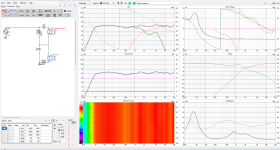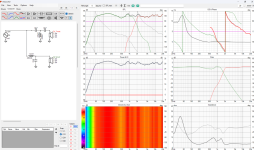Welcome to a super boring 2 way build
Well.... I have these Silver flutes laying around and decided to make a cheapo 2 way with them. They were originally meant for my car but wouldn't fit. Then I was going to throw them in the wife's car but.... also will not fit.
So screw it! Lets throw some more money into the pit in the form of a tweeter and some crossover components and see what happens.
I picked this Peerless tweeter to go with it. The built in waveguide lets me cross it quite low. Under 2k. This should, in theory, sound better that crossing it over inbetween 2-5k which, I am told, is not the best place to cross drivers since hearing is sensitive there. The waveguide puts the z offset of the tweeter mechanically close to the z offset of the woofer. I am going to test this to see how close they actually end up.
I'm going to throw a 0.4 cubic foot box at this and vent it. I will post the WinISD sim.
Just thought I'd share. I'll probably use these in my garage since both drivers have really good off axis specs.
Pretty simple, pretty boring, maybe they will sound pretty good.
Well.... I have these Silver flutes laying around and decided to make a cheapo 2 way with them. They were originally meant for my car but wouldn't fit. Then I was going to throw them in the wife's car but.... also will not fit.
So screw it! Lets throw some more money into the pit in the form of a tweeter and some crossover components and see what happens.
I picked this Peerless tweeter to go with it. The built in waveguide lets me cross it quite low. Under 2k. This should, in theory, sound better that crossing it over inbetween 2-5k which, I am told, is not the best place to cross drivers since hearing is sensitive there. The waveguide puts the z offset of the tweeter mechanically close to the z offset of the woofer. I am going to test this to see how close they actually end up.
I'm going to throw a 0.4 cubic foot box at this and vent it. I will post the WinISD sim.
Just thought I'd share. I'll probably use these in my garage since both drivers have really good off axis specs.
Pretty simple, pretty boring, maybe they will sound pretty good.
Attachments
-
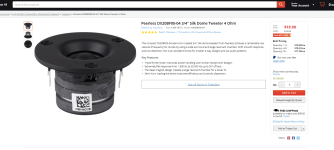 Screenshot 2024-09-03 151256.png125.7 KB · Views: 298
Screenshot 2024-09-03 151256.png125.7 KB · Views: 298 -
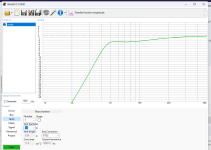 Screenshot 2024-09-03 151843.png20.9 KB · Views: 271
Screenshot 2024-09-03 151843.png20.9 KB · Views: 271 -
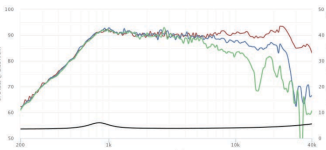 Screenshot 2024-09-03 124957.png67.9 KB · Views: 206
Screenshot 2024-09-03 124957.png67.9 KB · Views: 206 -
 Screenshot 2024-09-03 125247.png58.9 KB · Views: 243
Screenshot 2024-09-03 125247.png58.9 KB · Views: 243 -
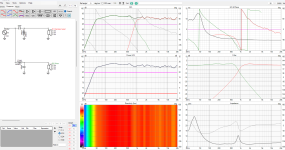 Screenshot 2024-09-03 144046.png67.4 KB · Views: 291
Screenshot 2024-09-03 144046.png67.4 KB · Views: 291 -
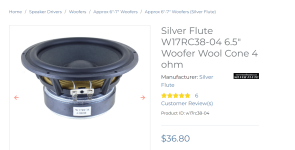 Screenshot 2024-09-03 151206.png143.7 KB · Views: 325
Screenshot 2024-09-03 151206.png143.7 KB · Views: 325
So this will be for an amplifier that work on 2Ω ?!?
You will need something like this, or redesign the crossover.
.
.
... and a 3/4 inch tweeter cut under 1Khz ?!? You plan to listen at under 1W total power?
You will need something like this, or redesign the crossover.
.
.
... and a 3/4 inch tweeter cut under 1Khz ?!? You plan to listen at under 1W total power?
If I have to yes. I will get a 2 ohm Taramps amplifier. This is a very cheap build.
That crossover is just me messing around. I will probably move the XO higher. We will see when I measure everything what the actual distortion of the drivers comes in as.
That crossover is just me messing around. I will probably move the XO higher. We will see when I measure everything what the actual distortion of the drivers comes in as.
Von,
I suppose I could run a series x over..... I have not tried that before.... interesting. Now its gotten a little more interesting.....
I suppose I could run a series x over..... I have not tried that before.... interesting. Now its gotten a little more interesting.....
A series crossover is more complicated than a standard xo. It is not just wiring the driver's in series. (I have never attempted one.)
However, a standard xo should be fine, you probably just need to refine your initial attempt. Using two 4-ohm drivers should allow you to create a 4-ohm 2-way speaker. The rule of thumb is to not go below 80% of the nominal impedance, so just keep your system impedance above 3.2 ohms.
However, a standard xo should be fine, you probably just need to refine your initial attempt. Using two 4-ohm drivers should allow you to create a 4-ohm 2-way speaker. The rule of thumb is to not go below 80% of the nominal impedance, so just keep your system impedance above 3.2 ohms.
I am by no means an expert. I merely thought series would help with impedance. The actual crossover details would take a lot of experimentation. I am by sheer luck and trial and error currently using a series crossover in my OB 3-ways. However, I started with concepts from very capable designers and played with Xsim until I found something encroaching on the universe of reasonable. Your attempt looks promising, though the parallel one has much less overlap.
I’m out of my depth on crossover design as soon as I say crossover.
I’m out of my depth on crossover design as soon as I say crossover.

The built in waveguide lets me cross it quite low. Under 2k. This should, in theory, sound better that crossing it over inbetween 2-5k which, I am told, is not the best place to cross drivers since hearing is sensitive there.
You were told wrong. Scrap the design and start over. 100 uF in the woofer LP is a bad idea.
I think I can figure it out if I throw some time at it. I have hour and sometime days long lulls at work where I can just throw my engineering time at personal projectsI am by no means an expert. I merely thought series would help with impedance. The actual crossover details would take a lot of experimentation. I am by sheer luck and trial and error currently using a series crossover in my OB 3-ways. However, I started with concepts from very capable designers and played with Xsim until I found something encroaching on the universe of reasonable. Your attempt looks promising, though the parallel one has much less overlap.
I’m out of my depth on crossover design as soon as I say crossover.
Here's a paralell and I'm right at 4 ohm. Just had to go 3rd order on the tweeter. Probably best since I'm crossing it so low.A series crossover is more complicated than a standard xo. It is not just wiring the driver's in series. (I have never attempted one.)
However, a standard xo should be fine, you probably just need to refine your initial attempt. Using two 4-ohm drivers should allow you to create a 4-ohm 2-way speaker. The rule of thumb is to not go below 80% of the nominal impedance, so just keep your system impedance above 3.2 ohms.
Attachments
Looks like a good start.Here's a paralell and I'm right at 4 ohm. Just had to go 3rd order on the tweeter. Probably best since I'm crossing it so low.
Depending on your answer to AllenB's question...may need to add y-offset.
If you use an air core inductor on the woofer that will add some DCR and i think raise the impedance a bit.
If you need to add a padding resistor to the tweeter, that raise the impedance a bit.
Overall, I doubt a low impedance will be a problem.
Search diyaudio and Tech Talk, maybe MAC, and see if you can find any posts on how low that tweeter can go. I did a quick search on my phone and didn't see anything, but I have those tweeters and looked into it before. I'm thinking 2.5khz but I put very little confidence in that recollection.
Where's your baffle step compensation????

Sometimes (rarely) woofers have this baked into the response by the manufacturer.
It appears the Silver flute manufacturer measurements are infinite baffle (concurs with Zaphs IB test sample). Therefore you'll likely need to target 87dB system sensitivity. Apply your baffle diffraction response to the manufacturer curve to see what I mean.
Sometimes (rarely) woofers have this baked into the response by the manufacturer.
It appears the Silver flute manufacturer measurements are infinite baffle (concurs with Zaphs IB test sample). Therefore you'll likely need to target 87dB system sensitivity. Apply your baffle diffraction response to the manufacturer curve to see what I mean.
Sometimes (rarely) woofers have this baked into the response by the manufacturer
Uhm, no. That only applies if the driver is so large that it beams before the baffle step occurs. That usually happens with 15"+ drivers.
Punktkilde drivers seem to have reducing efficiency with increasing frequency. These are IB / IEC measurements I believe. AS you can see the sensitivity reduces with increasing frequency. I'm not saying "no baffle step" - but you have to understand the measurement conditions of the driver whose FR you are using before you decide how much may be appropriate.
https://www.punktkilde.com/sites/default/files/product/specsheet/W ASDWD0001-0401_0.pdf
https://www.punktkilde.com/sites/default/files/product/specsheet/W ASDWD0001-0401_0.pdf
Just traced them. I'll pull measured data once the tweeter arrives. I'll build the box sometime this weekAre these your measurements or did you trace the datasheets?
Just traced them. I'll pull measured data once the tweeter arrives. I'll build the boxAre these your measurements or did you trace the datasheets?
All of this is theoretical at this point. I'm yet to take the actual measurementsWhere's your baffle step compensation????
View attachment 1352211
Sometimes (rarely) woofers have this baked into the response by the manufacturer.
It appears the Silver flute manufacturer measurements are infinite baffle (concurs with Zaphs IB test sample). Therefore you'll likely need to target 87dB system sensitivity. Apply your baffle diffraction response to the manufacturer curve to see what I mean.
- Home
- Loudspeakers
- Multi-Way
- A boring 2 way build

